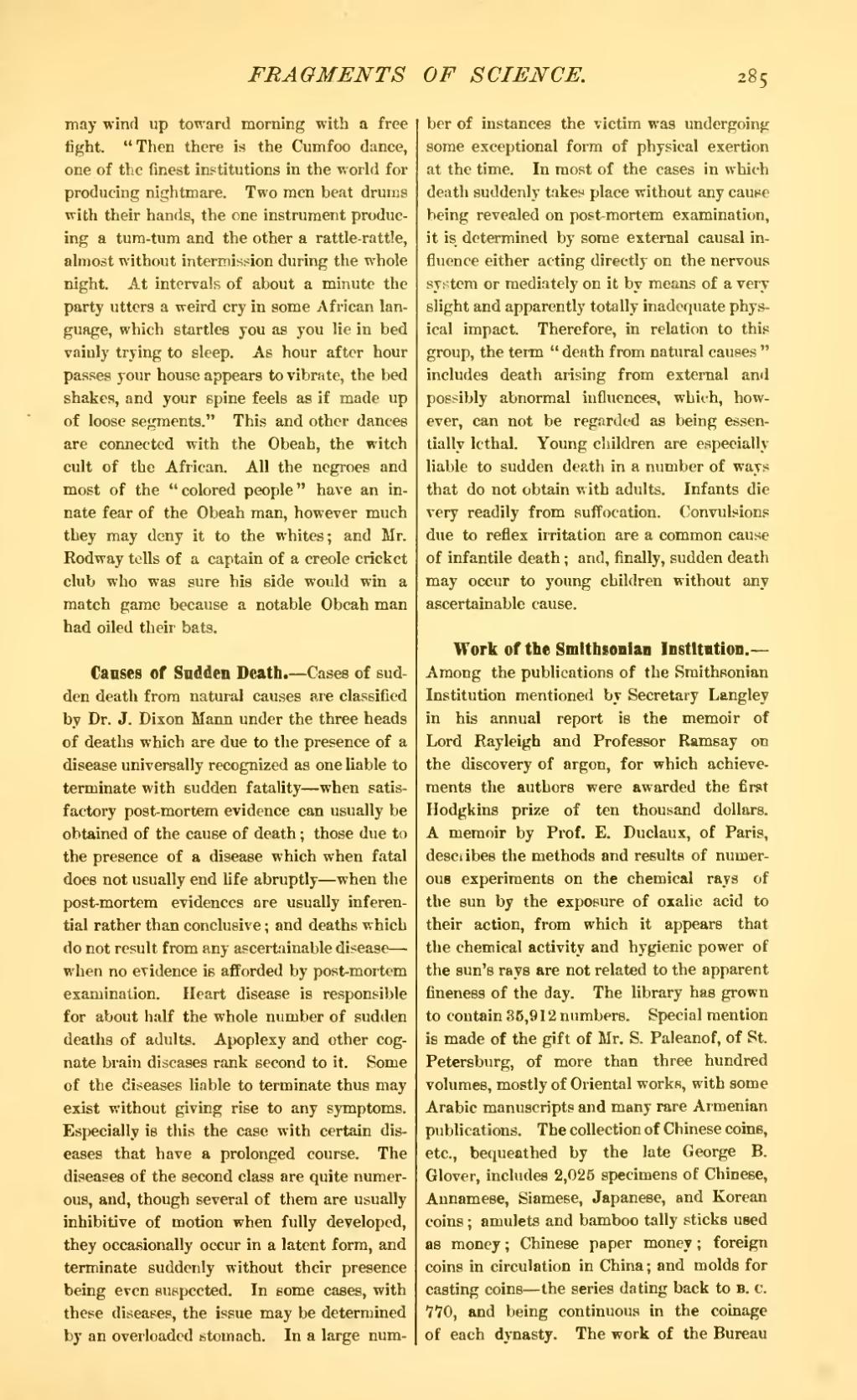may wind up toward morning with a free fight. "Then there is the Cumfoo dance, one of the finest institutions in the world for producing nightmare. Two men beat drums with their hands, the one instrument producing a tum-tum and the other a rattle-rattle, almost without intermission during the whole night. At intervals of about a minute the party utters a weird cry in some African language, which startles you as you lie in bed vainly trying to sleep. As hour after hour passes your house appears to vibrate, the bed shakes, and your spine feels as if made up of loose segments." This and other dances are connected with the Obeah, the witch cult of the African. All the negroes and most of the "colored people" have an innate fear of the Obeah man, however much they may deny it to the whites; and Mr. Rodway tells of a captain of a creole cricket club who was sure his side would win a match game because a notable Obeah man had oiled their bats.
Causes of Sudden Death.—Cases of sudden death from natural causes are classified by Dr. J. Dixon Mann under the three heads of deaths which are due to the presence of a disease universally recognized as one liable to terminate with sudden fatality—when satisfactory post-mortem evidence can usually be obtained of the cause of death; those due to the presence of a disease which when fatal does not usually end life abruptly—when the post-mortem evidences are usually inferential rather than conclusive; and deaths which do not result from any ascertainable disease—when no evidence is afforded by post-mortem examination. Heart disease is responsible for about half the whole number of sudden deaths of adults. Apoplexy and other cognate brain diseases rank second to it. Some of the diseases liable to terminate thus may exist without giving rise to any symptoms. Especially is this the case with certain diseases that have a prolonged course. The diseases of the second class are quite numerous, and, though several of them are usually inhibitive of motion when fully developed, they occasionally occur in a latent form, and terminate suddenly without their presence being even suspected. In some cases, with these diseases, the issue may be determined by an overloaded stomach. In a large number of instances the victim was undergoing some exceptional form of physical exertion at the time. In most of the cases in which death suddenly takes place without any cause being revealed on post-mortem examination, it is determined by some external causal influence either acting directly on the nervous system or mediately on it by means of a very slight and apparently totally inadequate physical impact. Therefore, in relation to this group, the term "death from natural causes" includes death arising from external and possibly abnormal influences, which, however, can not be regarded as being essentially lethal. Young children are especially liable to sudden death in a number of ways that do not obtain with adults. Infants die very readily from suffocation. Convulsions due to reflex irritation are a common cause of infantile death; and, finally, sudden death may occur to young children without any ascertainable cause.
Work of the Smithsonian Institution.—Among the publications of the Smithsonian Institution mentioned by Secretary Langley in his annual report is the memoir of Lord Rayleigh and Professor Ramsay on the discovery of argon, for which achievements the authors were awarded the first Hodgkins prize of ten thousand dollars. A memoir by Prof. E. Duclaux, of Paris, describes the methods and results of numerous experiments on the chemical rays of the sun by the exposure of oxalic acid to their action, from which it appears that the chemical activity and hygienic power of the sun's rays are not related to the apparent fineness of the day. The library has grown to contain 35,912 numbers. Special mention is made of the gift of Mr. S. Paleanof, of St. Petersburg, of more than three hundred volumes, mostly of Oriental works, with some Arabic manuscripts and many rare Armenian publications. The collection of Chinese coins, etc., bequeathed by the late George B. Glover, includes 2,025 specimens of Chinese, Annamese, Siamese, Japanese, and Korean coins; amulets and bamboo tally sticks used as money; Chinese paper money; foreign coins in circulation in China; and molds for casting coins—the series dating back to b. c. 770, and being continuous in the coinage of each dynasty. The work of the Bureau

